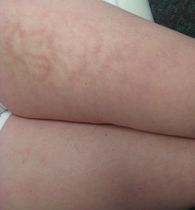- General Dermatology
- Eczema
- Chronic Hand Eczema
- Alopecia
- Aesthetics
- Vitiligo
- COVID-19
- Actinic Keratosis
- Precision Medicine and Biologics
- Rare Disease
- Wound Care
- Rosacea
- Psoriasis
- Psoriatic Arthritis
- Atopic Dermatitis
- Melasma
- NP and PA
- Skin Cancer
- Hidradenitis Suppurativa
- Drug Watch
- Pigmentary Disorders
- Acne
- Pediatric Dermatology
- Practice Management
- Prurigo Nodularis
Article
Technology's downside: Laptop computers, other devices can cause skin changes
Even relatively common skin conditions can present themselves in ways that make their diagnosis a bit more challenging than many of the cases dermatologists see every day. Laptop computers resting on the thigh, for example, may lead to erythema ab igne.

Key Points

Pediatric dermatologist Jon A. Dyer, M.D., University of Missouri's department of dermatology and child health, recently saw such a patient.
A 14-year-old girl came into his clinic with what was described as a month-old "rash" - a hyperpigmented patch - on her thigh. It wasn't tender, itchy or scaling, but it persisted.
Dr. Dyer diagnosed the condition as erythema ab igne, a skin condition resulting from long-term exposure to radiation.

"Her computer had overheated about a month earlier to the point of destruction, with the battery resting on the girl's left leg," Dr. Dyer says.
The condition was not unique, but Dr. Dyer says the cause is a relatively recent phenomenon.
"I think it's only been in the last year or two people have been reporting erythema ab igne from the computer.
"I'm sure I saw it on the thigh like this before it was described, but just didn't pick up it was from a laptop," he says.
Dr. Dyer says it more often occurs in locations such as the lower back, where a person might use a heating pad turned on too high too often.
Unfortunately, what may appear to be a minor aggravation can result in a long-term problem.

"Basically, the vasculature is dilating, trying to carry away all that extra heat, and over a chronic period of time, it can't do it, so it leaves those marks.
"Mild changes will typically resolve, but if exposure has been ongoing for a long period of time, they may not," Dr. Dyer tells Dermatology Times.





